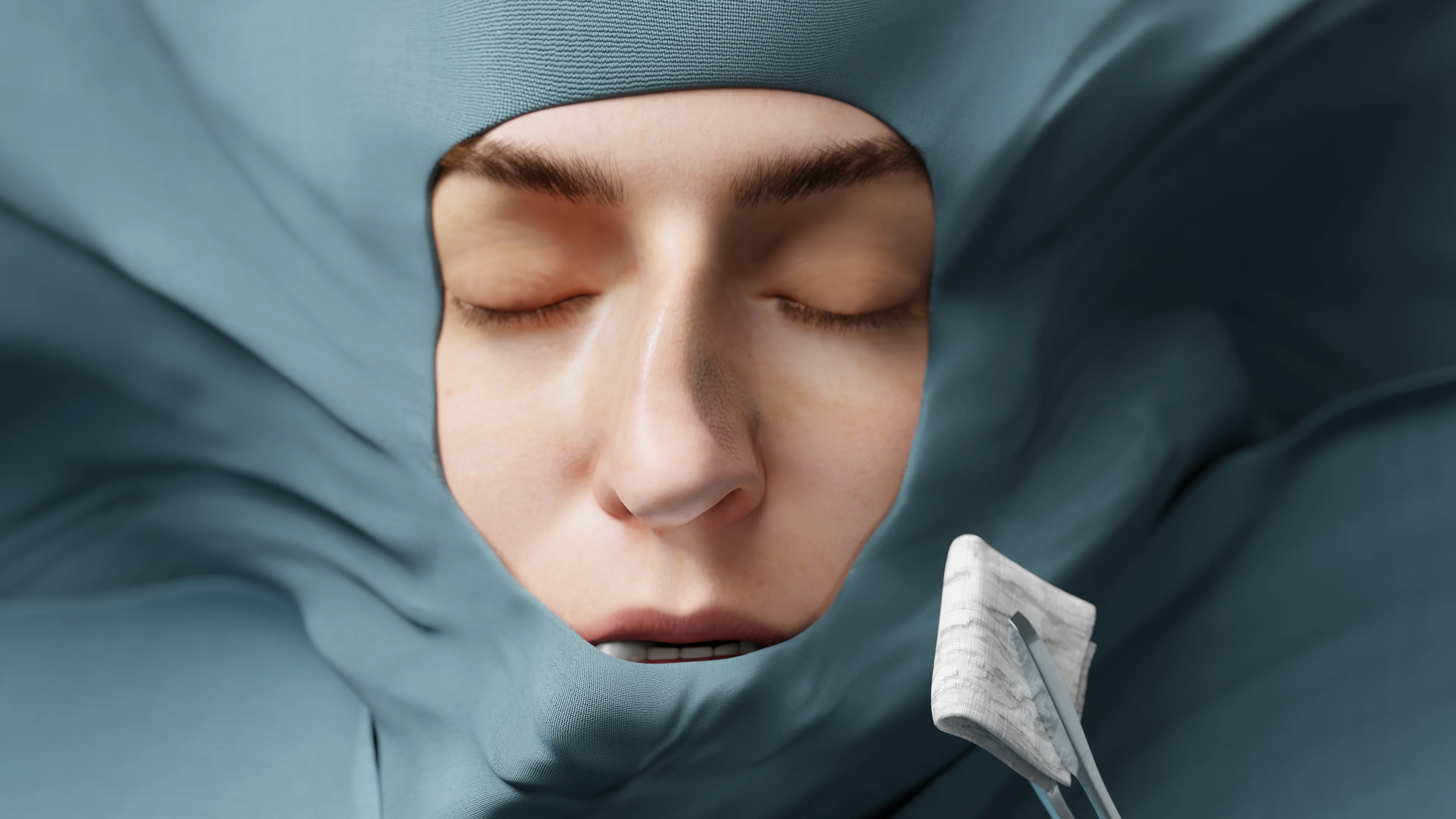Deviated Septum: Aetiology, Classification, Symptoms, Diagnosis and Treatment
Deviated septum: aetiology, classification, symptoms, diagnosis and treatment. Diagnostic methods and the main treatment method are described.
Alterations in the shape of the external nose may be associated with a congenital or acquired defect of the external nose. These changes may cause aesthetic dissatisfaction or even impair an individual’s breathing function.
The condition typically affects the cartilaginous and/or bony parts of the pyramid.

Changes in nose shape may be caused by various factors:
Leonardo da Vinci is thought to have devised the theory of ideal facial symmetry, also known as the golden ratio, which is now used to determine nasal irregularities. According to his theory, the left and right halves of the face should mirror each other.
Da Vinci also introduced the golden ratio (1 : 1.618) concept, which helps identify the right facial proportions. The intervals between facial features (eyes, nose, mouth) should correspond to this ratio.
To analyze the facial profile, modern plastic surgery utilises geometric lines and points, such as the nasion, rhinion, pronasale, and subnasale, and determines the nasofrontal and nasolabial angles. When the proportions are distorted, the external nose shape is considered to be altered.
Note that this article does not deal with the aesthetic analysis of the face. Below, you can find the most common types of nasal deformities.
Currently, there is no established classification system for external nasal deformities. Our goal is to describe the most common types.
When the cartilaginous part of the nose fails to develop properly, the columella, apex, and alae of the nose change their shape, position and orientation. Nasal cartilages are also responsible for the stiffness of the distal third of the nasal dorsum. The bony part of the nose is responsible for the shape of the bridge of the nose, the profile of the nose, and the presence of a hump or saddle-shaped deformity.
These conditions affect the appearance of the nose and may impair its functions, such as breathing or smelling.
A healthcare professional should perform a visual examination to evaluate the external nose shape and ask the patient about complaints.
The external nose shape may be corrected using minimally invasive techniques. These include fillers injected into specific areas of the nose. However, this method is not suitable for more severe defects and the result is temporary.
Surgical therapy aims to correct the external and/or internal nose, its appearance, and breathing function. Depending on the deformity type, rhinoplasty may be either closed or open.
Rhinophyma results from persistent chronic inflammation of the skin secondary to rosacea. It is very common among middle-aged and senior males and is rarely seen in females. Genetic predisposition is also one of the key factors. Prolonged UV exposure and unhealthy lifestyles (smoking, alcohol abuse, excessive consumption of spices) tend to exacerbate the condition. Hormonal disorders may also promote and aggravate rhinophyma.
Connective tissue, blood vessels, and sebaceous glands start to proliferate secondary to chronic skin inflammation. Gradually, the nasal skin develops dense red nodules covered with superficial vessels. Then the nodules transform into cyanopurpuric tuberous build-ups, and telangiectasia may develop. Sebaceous glands become significantly enlarged and produce excessive amounts of discharge.
Patients are primarily concerned about their disfigured appearance. Their nose becomes cyanotic, tuberous, and significantly enlarged. The pores are also bigger, and the skin is oily and shiny. In extreme cases, the condition may cause pain and discomfort. Symptoms tend to worsen over time.
Diagnosis is based on medical history and a physical examination. Dermatologist/cosmetologist advice is generally recommended.
Medical treatment may halt the disease.
Patients are advised to break their bad habits and limit exposure to high temperatures and UV.
Antibacterial ointments, azelaic acid, and retinoids have proven to be effective.
Laser treatment of pathologically altered tissues may be an option. This method targets hypertrophied vessels and reduces inflammation.
Significant overgrowth of the external nasal tissues typically necessitates surgery. In this case, specialised tools and electric impulses are used to excise excessive tissues.
1. What are the main types of external nasal deformities?
2. What are the causes of rhinophyma and how quickly does it develop?
3. How is rhinophyma treated?
4. What are the common causes of external nasal deformities?
5. How are structural deformities of the nose, such as rhinokifosis or rhinoscoliosis, treated?
References
1.
VOKA Catalogue. [Electronic resource].
https://catalog.voka.io/2.
Total Otolaryngology—Head and Neck Surgery, Anthony P. Sclafani, Robin A. Dyleski, Michael J. Pitman, Stimson P. Schantz. Thieme Medical Publishers, Inc., 2015. ISBN 978-1-60406-646-3.
3.
Бербом Х. Болезни уха, горла и носа / Ханс Бербом, Оливер Кашке, Тадеус Навка, Эндрю Свифт; пер. с англ. – 2-е изд. – М. : МЕДпреcс-информ, 2016. – 776 с. : ил. ISBN 978-5-00030-322-1.
4.
Suh, M. K., & Jeong, E. (2018, June). Correction of deviated nose. Archives of Craniofacial Surgery, 19(2), 85–93. DOI: 10.7181/acfs.2018.01914. PMID: 29996638; PMCID: PMC6057124.
5.
Sam, A., Deshmukh, P. T., Patil, C., Jain, S., & Patil, R. (2012, December). Nasal septal deviation and external nasal deformity: A correlative study of 100 cases. Indian Journal of Otolaryngology and Head & Neck Surgery, 64(4), 312–318. DOI: 10.1007/s12070-011-0311-x. PMID: 24294569; PMCID: PMC3477430.
6.
Rhinoplasty Archive. Rhinoplasty Dissection Manual. Chapter 1. [Electronic resource].
https://www.rhinoplastyarchive.com/articles/rhinoplasty-fundamentals/rhinoplasty-dissection-manual-chapter-17.
Kao, W. K., & Ho, T. (2023, December). The management of posttraumatic nasal deformities. Facial Plastic Surgery, 39(6), 630–637. DOI: 10.1055/a-2152-8670. PMID: 37567568.
8.
Huseynov, J., & Mozet, C. (2020, November). Übersicht und aktuelle Empfehlung zur Therapie des Rhinophyms [A systematic review and current recommendation for treatment of rhinophyma]. Laryngorhinootologie, 99(11), 772–778. DOI: 10.1055/a-1208-5284. PMID: 33111293. (In German).
9.
Chauhan, R., Loewenstein, S. N., & Hassanein, A. H. (2020, August 11). Rhinophyma: Prevalence, severity, impact and management. Clinical, Cosmetic and Investigational Dermatology, 13, 537–551. DOI: 10.2147/CCID.S201290. PMID: 32848439; PMCID: PMC7429105.
Link successfully copied to clipboard